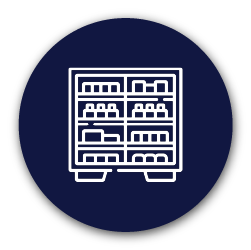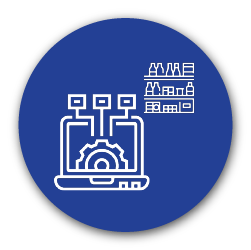If you work in retail, you’ve probably come across more than one planogram before. But what are they really, and how’d they come to play such an important role in retail optimisation? Planograms are essentially the tool you use when you want to merchandise your products on the shelf. They’re a visual representation of what your shelf should look like.
But planograms aren’t only for your benefit as a retailer, there’s a little more to them than that. As much as a planogram allows retailers to maximise their sales, they also play a critical role in creating a pleasant and effective shopping experience for your customers. Of course, planograms weren’t always around to help out, and that’s when inefficiencies and guesswork begin to take a heavy toll.
There once was a time when you’d place your products on the shelf without knowing that there was a better, more efficient way of doing so. That’s not a slight on any retailer - no one knew any better back then.
Product placement has come a long way since those helter-skelter days. In this article, we’ll touch on the origins of the planogram exploring how these instruments of retail optimisation have evolved into the helpful tools of today.
The genesis of planograms has led to what they have become today - a critical merchandising tool that any retailer (or supplier) worth their salt should use to present their products in-store.
But it’s not only about their genesis. It’s all good and well knowing how they came about. It’s just as important to understand their role in today’s retail industry. And then, have a sneak peek at their future. After all, the retail industry is ever-changing, and your customer’s demands have changed too. The technology that supports you thus needs to evolve with them.
 Where did planograms originate?
Where did planograms originate?
When comparing planograms to other physical retail technology, you could argue that they form the grandfather and/or grandmother of modern retail. That's true if you compare it to modern-day innovations such as cashier-less checkouts, QR codes, in-store customer analytics, AI, and machine learning.
However, you could argue that the concept of planograms is also still relatively new. Do a little research and the overarching understanding is that Kmart came up with planograms in the early 1970s. That was barely 50 years ago.
A planogram is a diagram, drawing or visual representation that indicates how and where to place products on a shelf. It’s built using retail data such as sales, units, SKU and fixture information to plan, communicate, implement and maintain merchandising strategies.
One Door CEO Tom Erskine and retail consultant and author Andrew Smith discuss its origins in a RETHINK Retail podcast.
Erskine says, “Kmart invented the technology of the paper planogram. They were the first ... to figure out that if you optimally placed products in a particular place, in a store, you could sell more. And so they used this way of communicating to their associates.”
Looking to build planograms for your store? Have you tried DotActiv Free?
Since then, this invention has developed into a key merchandising tool that you can’t do without. That’s if you consider its end goal:
To increase your sales and profitability by ensuring your shelf displays offer the right selection of products to reach your shoppers at the right time and place.
We’ll touch on this in more detail below. However, the point remains. Planograms are critical to your everyday function as a retail business.
 What role do planograms play today?
What role do planograms play today?
Officially or unofficially, planograms are 50 years old - or thereabouts. That might put them on the level of the grandparents of retail technology, but it doesn’t negate the hugely positive role or the impact they’ve had on it.
Here’s a look at the purpose of a planogram:
A planogram gives your executive management or head office more control over how products are displayed and implemented in stores and allows you to maintain and review shelf layouts based on the performance and success of the planograms.
You can understand how critical they can be if you implement them correctly. That should also indicate the impact of incorrect implementation. Of course, the above is only an idea of what their role includes.
It’s also worth understanding their impact on your bottom line and the benefits. Below are only a handful of the many advantages of using planograms across your stores:
- Space elastic demand: The amount of space allocated to a product has a significant impact on its sales. It is thus imperative to provide products that are both popular and profitable with enough space.
- Centralization: Planograms can dictate the layout of your store and server as an opportunity to be consistent in everything you do. Your customers can enjoy the same shopping experience no matter which of your stores they visit.
- Stock control: Effective planograms ensure consistency of the days of supply for the products on a shelf, making the shelf replenishment cycle easier. You also lessen the risk of running out of stock or holding the wrong inventory.
- Visual appeal and tactical positioning: A planogram is a visual representation of what’s on your shelf and, with data added to the mix, they allow you to position your products to make it easier for your customers to shop in-store.
Want to build a performance-enhancing planogram that’ll increase your sales? Download our Free Ebook
So when is it best to build planograms? For context, you’d usually design them a month or two before implementation.
- When seasons change;
- If you update your assortment;
- If you plan to open a new store; or
- When you refine your category management strategy.
If you notice anything interesting about the above reasons to build planograms, you’ll understand the need to design shelf plans continually. There is never a time when you shouldn’t need to create them. If you finished building a planogram, it’s time to look at the data and understand where you can improve.
In continually re-designing your planograms, you can ensure to refine the space allocations of each product for optimised sales and customer satisfaction.
It’s also worth pointing out that planograms are not solely for those retailers or suppliers with a big monthly budget and hundreds or even dozens of stores. Planograms are for every retailer, no matter your retail format, store size, or budget.
There are plenty of solutions on the market that can match your goals and objectives. For example, if you’re interested in a planogram software solution but don’t need an integrated database or a clustering feature. Or let’s say you don’t have the budget for an expensive option. DotActiv Lite is the perfect solution.

Where to next for planograms?
Currently, planograms use data to help ensure correct product placement on shelves. We’ve written dozens of articles on the critical role that data plays. Since the invention of planograms, data has taken them to the next level.
Take your sales data as an example. As we noted in a survey conducted by Retail Wire and data science firm, Alteryk, by using data analytics, including sales, you can gather shopper insights, which are critical to your performance.
If this is the ‘now’ of planograms, then where to next? Here are two potential futures, both of which are already in play to various degrees, that we think will have a big impact on the trajectory that our retail tools are headed.
Now, trying to see the future might defeat the purpose of asking “What’s next?”, but it still matters because the future is all about tweaking and improving what is already working. It’s not only about inventing new technology.
Planograms and Artificial Intelligence
For one, future planograms can (and should) incorporate more artificial intelligence. That makes sense if you consider the rate at which AI technology is developing.
Deloitte Consulting LLP’s lead specialist in cloud, data, and machine learning, Chida Sadayappan, and principal machine and deep learning engineer, Dinesh Kumar believe that AI has already begun to have an impact.
“Artificial intelligence (AI) and machine learning (ML) have started playing a critical role in the planogram assortment by helping to rank and recommend the products to maximize sales.”
There is also the hope that AI will allow for easier and better planogram implementation. Store compliance relating to planogram implementation is a major issue that needs to be addressed. Imagine being able to use AI to monitor planogram implementation. Wouldn’t that be a game-changer?
Changing planogram dimensions
Another interesting route is to take your traditional 2D planogram and convert it into a different dimension. That could be 3D or even 4D, depending on which is more viable or necessary. Some solution providers already offer this feature.
Imagine being able to update or make changes to shelves in-store while looking at an interactive planogram on an electronic device in a format that is much smarter than a PDF. That includes understanding how any merchandising efforts would affect the look and feel of the aisle as much as the shelf.
Mind you, this doesn’t negate or dismiss the need for a 2D planogram - those are still critical to retail optimization. Instead, it is more about supplementing the experience and making it easier to implement in-store. As mentioned above, store compliance can be a problem if not addressed.
Changes and future planogram development
No matter what the future holds for planograms, one thing is clear: as expectations change, so too must the technology that supports them. DotActiv understands this, which is why we’re continually innovating our products and services.
In the context of planogram development, smarter innovation must happen. That’s the nature of retail. As more retailers begin focusing on ecommerce, there is the potential for fewer customers to visit stores. In such cases, it’s critical to find new ways to entice them to return.
If you’re concerned about ecommerce overtaking in-person shopping, a new study by Morning Consult found that it’s unlikely to happen in 2022. The report found that fewer stores are expected to close than in 2021.
But that doesn’t mean you shouldn’t be prepared. The in-person retail experience will never go completely out of fashion. People will always want to physically interact with most products before buying them.
However, things are changing and, in all likelihood, retail is shifting towards a more hybrid model. That’s especially true around specific products that you’d like to touch and feel. Browse online and then get closer in-store. Alternatively, browse in-store to get closer and then purchase online.
Conclusion
Planograms will remain a critical part of your retail strategy. That doesn’t matter if you’re a small, medium, or large retailer. If you’re looking to please your customers when they visit your store, you need to present your products so that it’s easier for them to find what they want.
You need to be quick to innovate and embrace any changes in technology. More importantly, you need to move towards any solutions provider who can help you achieve your goals while continuing to provide shoppers with the products they want when they want them.
Are you looking for a planogram solution that can provide you with both? Let DotActiv help.
You can book a customized software demo with a DotActiv expert here or browse our different software editions on our online store here.


